The Meizu PRO 6 Review
by Matt Humrick on August 26, 2016 8:00 AM EST- Posted in
- Smartphones
- Mobile
- MediaTek
- Meizu
- PRO 6
Battery Life
Our battery life tests cover a few common workloads and make it possible to compare the runtime potential of one phone to another. To make the tests accurate and repeatable, we control as many variables as possible, including minimizing background tasks and calibrating each display to 200 nits at 100% APL.
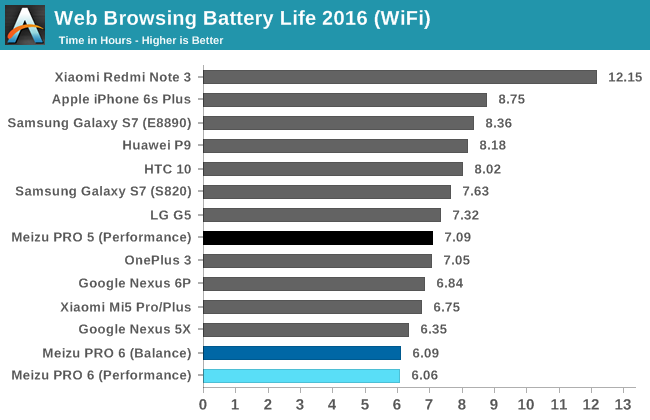
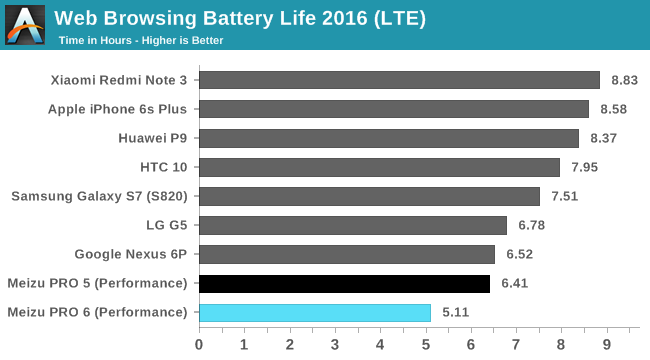
Our web browsing tests engage the CPU by pausing and then scrolling through each page after it’s loaded, and while the wireless radios consume some power too, display power draw continues to be the limiting factor in this workload.
The Meizu PRO 6 has a small battery. The average battery size for phones with 5.1-inch to 5.2-inch displays is about 3000mAh or 11.5Wh, which is 18% more than the PRO 6’s 2560mAh (9.73Wh) cell. It’s no surprise then to see it land at the bottom of the chart in our Wi-Fi browsing test, lasting just over 6 hours, a full 1 hour less than the PRO 5.
| Web Browsing Battery Life 2016 (WiFi): Average Platform Power (APP) | ||
| Phone | Display | APP (W) |
| Xiaomi Redmi Note 3 | 5.5-inch 1080p IPS LCD | 1.28 |
| Galaxy S7 (E8890) | 5.1-inch 1440p SAMOLED | 1.38 |
| Huawei P9 | 5.2-inch 1080p IPS LCD | 1.40 |
| Meizu PRO 6 | 5.2-inch 1080p SAMOLED | 1.61 |
| Meizu PRO 5 | 5.7-inch 1080p SAMOLED | 1.63 |
| Xiaomi Mi5 Pro | 5.15-inch 1080p IPS LCD | 1.72 |
Comparing average platform power (APP) numbers, a rough estimate of each phone’s average power consumption based on total runtime and battery capacity rather than an explicitly measured quantity, we see that both the Huawei P9 and Galaxy S7 (Exynos 8890), with similar size displays, consume about 13% less power than the PRO 6. It’s also interesting to see how close the APP is for the PRO 5 and PRO 6 when using their Performance modes (the PRO 5 drops to 1.54W in Balance mode) given the PRO 5’s larger display.
The PRO 6 loses 1 hour of runtime when switching to the cellular radio, with APP increasing 18% to 1.9W. Because the PRO 6, PRO 5, and Redmi Note 3 do not support US LTE frequency bands, they were forced to use WCDMA/HSPA+ instead, making direct comparisons to the other phones a bit more difficult; however, of these three phones the PRO 6 has the highest APP, followed by the PRO 5 and Redmi Note 3 both at 1.8W.
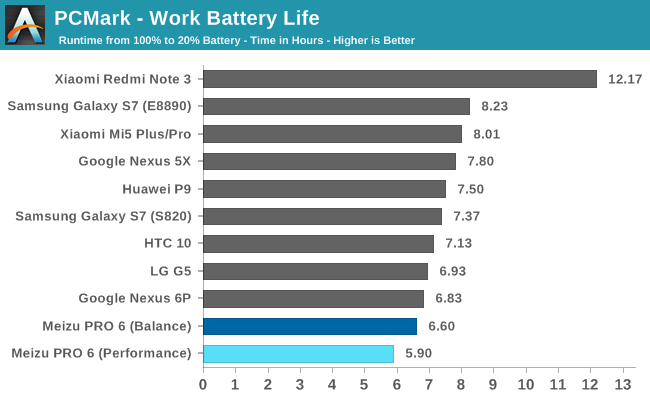

The PRO 6 and its small battery falls just shy of 6 hours using its Performance mode, hardly an impressive result when the Redmi Note 3 lasts twice as long and delivers nearly the same overall performance. The Huawei P9 outlasts the PRO 6 by almost an hour and delivers much better performance too. It’s a similar story with the Xiaomi Mi5: faster than the PRO 6 with almost 1.5 hours more battery life. The PRO 6 lasts 12% longer when using the Balance mode, basically putting it on par with the Nexus 6P.
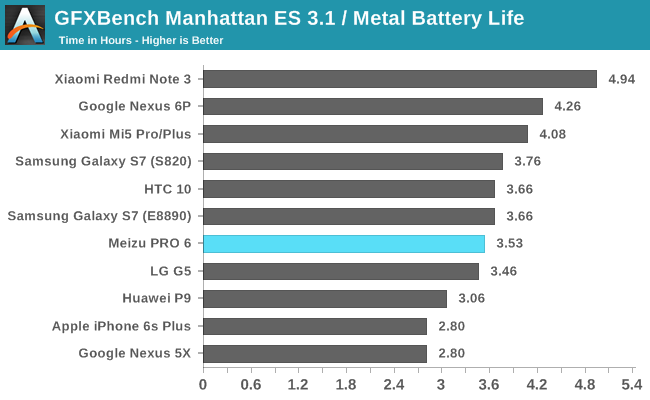
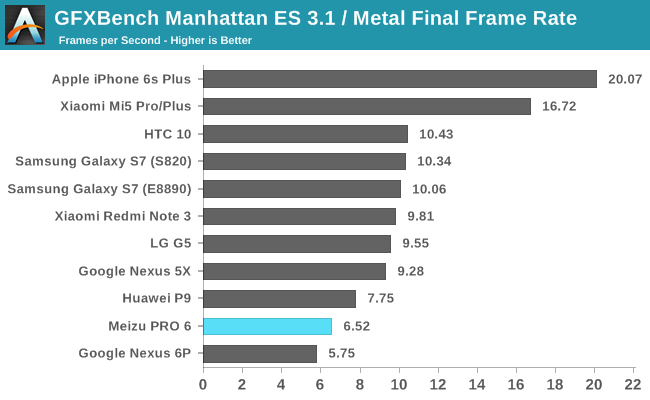
The PRO 6 lasts 3.5 hours in the GFXBench Manhattan 3.1 battery life test, which predicts runtime while playing games, an average result that’s diluted by poor performance. The Xiaomi Redmi Note 3, for example, lasts 1.4 hours longer and performs 50% faster at the end of the test. The Xiaomi Mi5 Pro lasts 33 minutes longer and is 2.5x faster. The PRO 6 does manage to outlast the Huawei P9, which has a larger battery and the same GPU, but it’s also 16% slower.
The GFXBench Manhattan 3.1 performance stability graph shows the PRO 6 can only maintain peak gaming performance for 15 minutes before it’s forced to reduce GPU frequency to avoid overheating. Frame rate reaches a relatively stable 7fps average after 30 minutes of gameplay. Thermal throttling reduces performance by 33% by the end of the test, a disappointing result for the Helio X25 SoC. The Huawei Mate 8, whose Kirin 950 SoC also uses a Mali-T880MP4 GPU, only drops 11% due to throttling, although it does have a larger frame to help dissipate heat.
3D Gaming Power Efficiency
The tables below quantify overall platform power efficiency while running 3D workloads. This should give us some additional insight into the PRO 6’s throttling behavior and battery life. The performance and power figures are averaged over the duration of each test, which last for approximately 1 minute. Before running the tests, we minimize background tasks, turn off all wireless radios, and calibrate the screens to 200 nits. Because of the short duration of the tests, these numbers represent the performance and power before any thermal throttling occurs.
Update 8/26/2016: The 3D power efficiency data has been updated to remove idle power consumption from the calculation.
| GFXBench Manhattan 3.1 Offscreen Power Efficiency (System Load Power) |
||||
| Mfc. Process | FPS | Avg. Power (W) |
Perf/W Efficiency |
|
| Galaxy S7 (Snapdragon 820) | 14LPP | 30.98 | 3.98 | 7.78 fps/W |
| Xiaomi Redmi Note 3 (Snapdragon 650) |
28HPm | 9.93 | 2.17 | 4.58 fps/W |
| Meizu PRO 6 (Helio X25) | 20Soc | 9.42 | 2.19 | 4.30 fps/W |
| Meizu PRO 5 (Exynos 7420) | 14LPE | 14.45 | 3.47 | 4.16 fps/W |
| Galaxy S6 (Exynos 7420) | 14LPE | 16.62 | 4.63 | 3.59 fps/W |
| Huawei P9 (Kirin 955) | 16FF+ | 10.59 | 2.98 | 3.55 fps/W |
The PRO 6 and its Helio X25 SoC uses the same or less power than the other phones in this comparison when running GFXBench Manhattan 3.1, despite using TSMC’s 20nm planar process. In the previous section we saw how the Mali-T760MP8 GPU in the Exynos 7420 delivers much better performance than the newer Mali-T880MP4 used in the Helio X25 and Kirin 955; however, this extra performance also requires more power, making the PRO 5 and Galaxy S6 a little less efficient than the PRO 6. It’s possible the T880’s architectural improvements partially offset the Exynos 7420’s process advantage here.
Another interesting point is that both the PRO 6 and Redmi Note 3 have the same average power consumption and nearly the same efficiency, but the PRO 6 experiences thermal throttling after looping through this test for 15 minutes while the Redmi Note 3 never throttles. Both phones get pretty warm, but the Redmi Note 3’s larger, thicker chassis and higher thermal mass seem to give it the edge in heat dissipation.
| GFXBench T-Rex Offscreen Power Efficiency (System Load Power) |
||||
| Mfc. Process | FPS | Avg. Power (W) |
Perf/W Efficiency |
|
| Galaxy S7 (Snapdragon 820) | 14LPP | 90.59 | 4.18 | 21.67 fps/W |
| Galaxy S7 (Exynos 8890) | 14LPP | 87.00 | 4.70 | 18.51 fps/W |
| Xiaomi Mi5 Pro (Snapdragon 820) | 14LPP | 91.00 | 5.03 | 18.20 fps/W |
| Apple iPhone 6s Plus (A9) [OpenGL] | 16FF+ | 79.40 | 4.91 | 16.14 fps/W |
| Xiaomi Redmi Note 3 (Snapdragon 650) |
28HPm | 34.43 | 2.26 | 15.23 fps/W |
| Meizu PRO 5 (Exynos 7420) | 14LPE | 55.67 | 3.83 | 14.54 fps/W |
| Xiaomi Mi Note Pro (Snapdragon 810 v2.1) |
20Soc | 57.60 | 4.40 | 13.11 fps/W |
| Galaxy S6 (Exynos 7420) | 14LPE | 58.07 | 4.79 | 12.12 fps/W |
| Meizu PRO 6 (Helio X25) | 20Soc | 32.46 | 2.84 | 11.43 fps/W |
| Huawei P9 (Kirin 955) | 16FF+ | 40.42 | 3.68 | 10.98 fps/W |
All of the phones see an increase in average power consumption when running GFXBench T-Rex. The Redmi Note 3 and its Adreno 510 GPU have the lowest power consumption of the group at 2.26W. The Snapdragon 820’s Adreno 530 GPU in the Galaxy S7 is the clear efficiency leader of the group, showing a 65% improvement over the Snapdragon 810 v2.1 in the Xiaomi Mi Note Pro we previously tested. The PRO 6’s efficiency is nearly the worst of the group when running T-Rex, although its average power consumption remains reasonable.
One of the points to take away from these two tables is that while an SoC’s manufacturing process plays a significant role in its power efficiency, it’s not the only factor to consider. Design decisions relating to CPU/GPU architecture and processor implementation details relating to trade offs between power and frequency or performance and area also play critical roles.
Battery Charging

The PRO 6 includes Meizu’s mCharge 3.0 fast charging technology. This system incorporates Texas Instruments’ MaxCharge components, including the BQ25892 battery charger IC that implements battery temperature monitoring and overvoltage/overcurrent protections. The charger that comes with the PRO 6 is rated for 5V, 9V, or 12V operation at 2A for a theoretical maximum of 24W at the wall. I actually measured a peak of about 21W at the wall and 14W at the battery.
The PRO 6 charges at 14W for about 25 minutes before gradually reducing input power. At this rate, the PRO 6’s battery charges to 25% in 11 minutes and 50% in 22 minutes. It’s fully charged in 1.5 hours, the same as the Galaxy S7. It’s also the same time as the PRO 5, which has a 19% larger battery. The PRO 5 matches the PRO 6’s charge time by using a higher peak voltage of 17.4W. Because the PRO 5 uses a similar charging system, it appears Meizu is being a bit conservative with the PRO 6, calibrating the charging system to hit 1.5 hours rather than stressing the battery further to minimize charge time.
Like many phones with fast charging, the PRO 6 reduces input power when charging the phone with the screen turned on, dropping down to 12W at the wall, which translates to 7.3W at the battery.


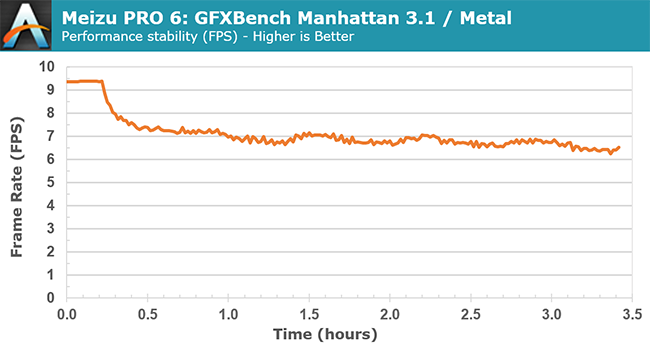
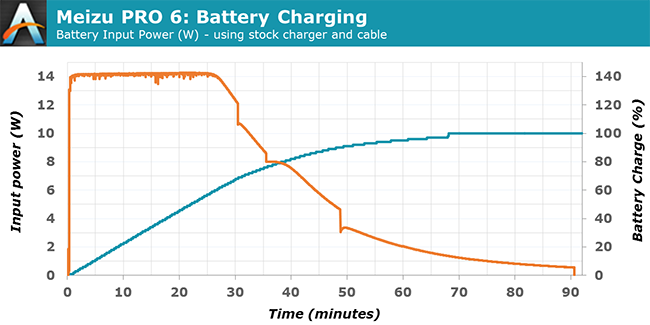








48 Comments
View All Comments
mczak - Friday, August 26, 2016 - link
The Helio X20/X25 does not compete with SD 820, neither with price nor performance. Nor efficiency (I'd argue that's impossible with planar 20nm). And I don't think it was meant to compete (it also for instance only has lte cat 6 vs cat 12 for the SD 820, not that I think this really makes much of a difference). The SD 650/652 though should be way closer in all relevant categories - price, performance, efficiency, features. (Personally I'd take a SD 650 over a X25 any day, because it appears to be a bit more efficient - I have no idea which one is cheaper though.)serendip - Saturday, August 27, 2016 - link
The X20/X25 is supposed to be Mediatek's flagship SoC but it can barely compete against a cheap low-end chip like the SD650 in the Redmi Note 3. I don't know if it's Meizu's poor kernel tuning configs or if the X20 has a suboptimal 3-cluster setup. To me, that mid range cluster seems redundant when an efficient A53 cluster should be the main processing cluster with fast A72 cores being used for bursty tasks, for a fast race-to-idle.serendip - Saturday, August 27, 2016 - link
The Xiaomi Redmi Note 4 with the X20 was just launched in China. I'd like to see a comparo between an X10 Note 3, SD650 Note 3 and X20 Note 4 - as they're all from the same manufacturer, software and tuning should be similar so any differences would be down to the SoC.colinstu - Friday, August 26, 2016 - link
So mediocre performance and basically the worst battery life. Got it.zodiacfml - Monday, August 29, 2016 - link
LOL. This cracked me up. I don't know why. Maybe there's too many devices coming out there, and we have little time to spend on each mediocre device.Personally, when it comes to actually buying an Android, it should be a Nexus or nothing at all. I can't even accept that Android 7.0 is not coming to Nexus 5 which is still flagship performance to me (I just don't like its battery life though).
TheinsanegamerN - Monday, August 29, 2016 - link
See, thats the thing. Nexus phones have poor battery life. Google needs to enforce something closer to 6-7 hours of SoT, not this 3.5 hour BS theyve been doing.Also, blame qualcomm for the lack of 7.0. They refuse to make GPU drivers for the SD80x line for 7.0.
Daniel Egger - Friday, August 26, 2016 - link
Funny, there're now so many keywords which make me stop reading phone reviews: Usually I manage to get all the way to the ridiculous display size but in this case the CPU is the clear no-go.tipoo - Friday, August 26, 2016 - link
That's a pretty elegant way to do the antenna lines.Meteor2 - Friday, August 26, 2016 - link
I'll be shot down... But I really like the Octane benchmark. Please include it in reviews!Eden-K121D - Friday, August 26, 2016 - link
Great review Matt.Basically yuck phone